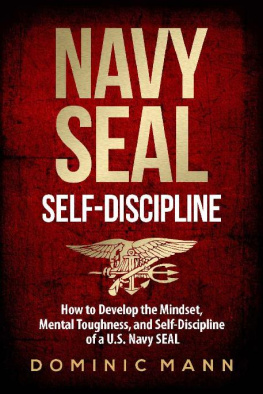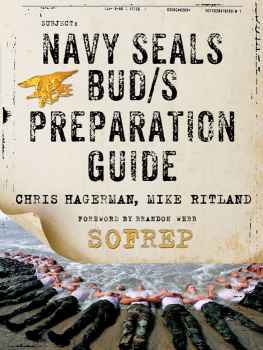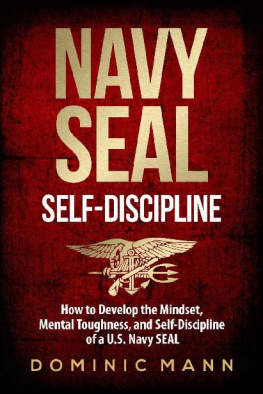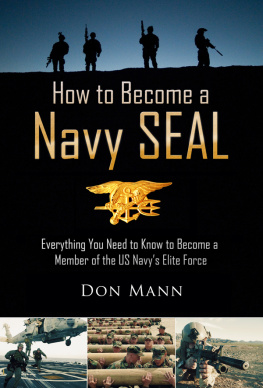Navy SEAL Mental Toughness
A Guide to Developing an Unbeatable Mind.
2016 Chris Lambertsen. All Rights Reserved.
Table of Contents
Preface
In my many years of experience studying high-achievers, I have found that many of the same qualities that are essential to succeed as a Navy SEAL are the same qualities required for success in any endeavor.
This book will introduce to you some of the methods used by this elite force to develop mental toughness and self-confidence in their warriors. These techniques also apply to anyone who is interested in becoming more mentally tough, and who is willing to work toward achieving their specific personal and professional goals.
Learning about how Navy SEALs approach situations and the mentality with which they function, will enable you to contrast your outlook and mindset when faced with challenges or obstacles.
By reading this book you are already a step closer to success. Learn from these extraordinary men and then adhere to their methodology, and I can guarantee positive results on your journey toward your goals!
Navy SEAL Training
The road to becoming a Navy SEAL is long and hard. Following is a short summary of the stages that make up the Navy SEAL selection and training courses that every SEAL must go through in order to become a member of this elite force.
STAGE 1: Naval Special Warfare Prep School
(8 Weeks Great Lakes, Illinois)
For the majority of prospective SEALs, the journey to becoming a member of the Teams begins after the completion of basic training (boot camp) and assignment to Prep School. This course averages eight weeks in duration, and is supervised by active-duty SEALs and other Naval Special Warfare personnel. In this course, there is a heavy emphasis on physical conditioning. The goal is to condition students to the point where they meet or exceed the established standards for admission to BUD/S, and also to ensure their bodies are toughened to the degree necessary to survive the rigors of the subsequent BUD/S orientation course and BUD/S First Phase.
STAGE 2: BUD/S Orientation Course
(3 Weeks Coronado, California)
During this course students become familiarized with the Naval Special Warfare Training Center at Coronado and get their first real taste of the daily routine associated with being a BUD/S student. Physical training (PT) remains a top priority, and the intensity of the PT sessions means they train at a much higher level. The students are taught how to make their way, properly and safely, through the legendary BUD/S obstacle course. They also receive basic instruction on some of the equipment that they utilize in First Phase. The students remain in Coronado until they graduate from BUD/S or are dropped from the training program.
STAGE 3: BUD/S First Phase Basic Conditioning
(7 Weeks)
The primary mission of First Phase is to eliminate the students who lack the will or the physical ability to successfully complete BUD/S. This filtering process is achieved by continuous, rigorous physical-training sessions and other training evolutions. These evolutions are all associated with various training and educational goals, but the reality is that everything about First Phase is designed to push the students to the edge of their perceived physical and mental limitations. As you might expect, First Phase has the highest attrition rate for BUD/S classeshistorically around 75 percent.
During this phase the standards and scores required to pass various evolutions and graded events are elevated at the beginning of each week, making each week of First Phase tougher than the previous one. In addition to physical training, students are exposed to various water-related training evolutions, both in the Pacific Ocean and in the BUD/S training pool. A great deal of emphasis is placed on development of a team mentality and teamwork among the students. The class is broken down into boat teams consisting of six to eight students, and almost every training evolution is conducted as a competition, pitting one boat team against the others, and the losers pay a high price.
The fourth week of this phase is devoted to the infamous and much-feared Hell Week, which is a 5-day evolution consisting of nonstop physical training and other activities designed to make the students colder and more exhausted than they have ever been. This is, of course, intended to make each student continually reflect upon just how badly he wants to be a Navy SEAL. For many, the rigors of Hell Week are simply more than they can endure, and throughout the week, it is quite common to hear the brass bell being rung three times as yet another student quits the course. Hell Week will be covered in greater detail in the next chapter, since it is such an important factor in the development of the mental toughness thats associated with Navy SEALs.
STAGE 4: BUD/S Second Phase Combat Diving
(7 Weeks)
During this phase students are trained as basic combat swimmers. Successful Second Phase candidates demonstrate a high level of comfort in the water and the ability to perform in stressful, and often uncomfortable, situations. Candidates who are not completely comfortable in the water often struggle to complete this phase.
As you might expect, students spend the majority of their time in the water learning and practicing various surface and underwater skills. Throughout this phase the students will be evaluated regarding their competence and confidence while in the waterboth attributes are absolute necessities for a Navy SEAL.
The students are introduced to open- and closed-circuit diving. Both techniques are commonly used in operational units. There is a significant amount of classroom instruction associated with learning both types of diving, making this phase as academically challenging as it is physically challenging. In addition to training to become a combat swimmer, the students are continually challenged by various graded physical-training evolutions, such as timed distance runs, open ocean swims, and, of course, the ever-present obstacle course.
STAGE 5: BUD/S Third Phase Land Warfare Training
(7 Weeks)
During this phase the students get their first real exposure to the many tools and techniques that are related to their chosen profession or specialty. They receive instruction on a variety of small arms, and they spend quite a bit of time becoming proficient in their use. Also covered in great detail is the employment of various types of explosives, land navigation, patrolling, rappelling, marksmanship, and small-unit tactics.
Most of the classroom instruction associated with this phase takes place at the BUD/S training compound. The last few weeks of the phase are spent on San Clemente Island, where the Navy maintains live-fire ranges and demolition ranges. Students run through a series of graded evolutions and practical-application exercises during their time on the island.
Throughout this phase the emphasis on physical training remains high and, as always, standards and passing scores for timed runs, swims, and the obstacle course are progressively elevated to ensure that the students find each subsequent week more demanding than the previous one. This continues until the class reaches the long-awaited BUD/S graduation ceremony.
STAGE 6: SEAL Qualification Training
(26 Weeks Various Locations)
Once the students have successfully completed BUD/S, they attend a course known as SEAL Qualification Training (SQT). This training is designed to transition the students from basically-trained combat swimmers and warriors to highly-trained special operators. They must become proficient in many individual and team-based skills, which are essential if they are to operate successfully as a fully qualified SEAL. In essence, this training is very much a finishing school that is intended to produce graduates who can be assigned to an operational unit. The goal is to produce SEALs who are immediately capable of performing alongside more seasoned and more experienced teammates.







